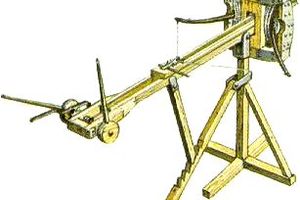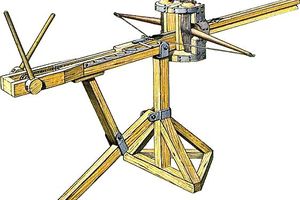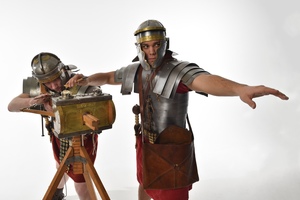Scorpion
Scorpion (Latin: scorpio) was the ancient Roman name for a type of projectile weapon similar to a ballista (a small arrow shooter).
No technical descriptions of the Scorpion's throwing mechanism have survived. Information about them mainly concerns their tactical use, from which conclusions about their design are drawn. Additionally, in the 4th century, the Greek-speaking author Ammianus Marcellinus referred to a different weapon—onager— as a scorpion.
 Structure of the Scorpion
Structure of the Scorpion
Structure of the Scorpion:
1. Guide rail with a dovetail key
2. Groove for the arrow and the arrow in the guide rail
3. Bundles of twisted sinews (right and left)
4. Lever in the free position
5. Bowstring in the free position
6. Barrel of the weapon with a dovetail groove; the rail with the dovetail key moves within this groove
7. Toothed racks on the right and left side of the weapon's mount, with which the guide rail's latch engages when returning to its original position using the rope (9). The rope is tied to a double prong (8) attached to the bowstring.
8. Double prong
9. Rope wound around the capstan (10) when the tensioning levers (4) bring the bowstring (5) into tension
10. Capstan
11. Trigger mechanism, which raises the latch connected to the teeth so that the guide rail is released, propelling the arrow towards the target
12. Weapon stand (a wooden beam construction)
13. Movable handle for adjusting vertical aim
14. Adjustable support for horizontal aim
The first mentions of Scorpions date back to the 3rd century BC, and they were initially used by Rome's adversaries. Polybius, in his description of the Roman siege of Syracuse, briefly defined the Scorpion as "a small catapult that shoots iron darts." However, the term "catapult" referred to a broad class of projectile weapons, and it is unclear from this definition whether Scorpions were two-armed torsion machines like catapults in the strict sense or merely heavy crossbows, i.e., mechanized bows. Nevertheless, the 4th-century author Vegetius distinguishes Scorpions from crossbows, although his definition of the Scorpion adds little clarity: "What we now call handheld ballistae were formerly called Scorpions; they were named so because their small, slender arrows bring death."
By the 4th century, catapults were universally known as ballistae. The 1st-century BC author Vitruvius, in his description of the catapult's mechanism, also mentions Scorpions. It is clear from the context that the arrow-throwing mechanism of the Scorpion operated on the same principles as the catapult. Vitruvius also noted that the Scorpion could be operated by one person, indicating that the Scorpion was a mounted machine.
Thus, Scorpions were two-armed torsion arrow shooters (catapults) operated by a single person. There were also smaller versions known as manuballistae (literally "handheld ballistae").





